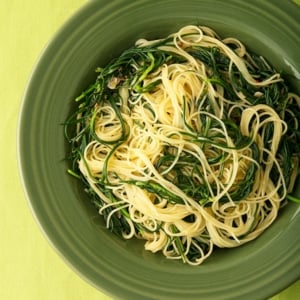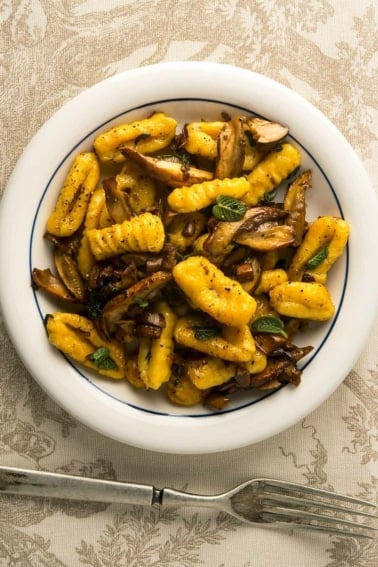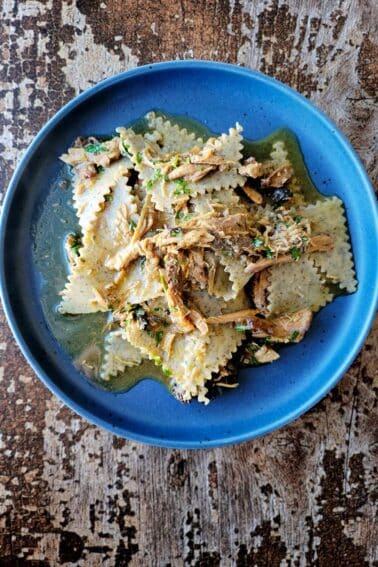As an Amazon Associate I earn from qualifying purchases.

Agretti is just sexy. Lacy, delicate, but packed with flavor, this relative of the sea bean is one of the most unusual residents of my garden.
Growing and cooking agretti is easy, too, once you learn a few tips and tricks.
Let’s start with what is agretti: It is one of a group of “saltworts” that were once burned to make the alkali soda ash used in glassmaking. Many of you know about sea beans, which are also called samphire, glasswort, sea asparagus and chicken feet. (More on that plant here.)
To my knowledge, you can’t grow sea beans in a regular garden, but I’ve tried growing its cousins several times. My first try was a Japanese version called okahijiki, Salsola komarovi, for which you can buy seeds here. It’s nice enough, but very floppy.
After that, I went Italian and grew agretti. I get my agretti seeds from Seeds from Italy. They’re not cheap, and growing it is always a gamble because the seeds have a very low germination rate, about 40 percent, and a short shelf life — only about 6 months.

I live near Sacramento, California, so I was able to plant my seeds at the beginning of April. By early June they are ready to harvest, fully grown but before they have set seed. Once germinated, growing agretti is easy: Just add water. No fertilizer needed and they are drought tolerant. Just give them at least six hours of sun per day.
You will see many pictures of agretti plants at the market that have been pulled up by the roots; I don’t recommend this. It’s main stem gets woody, so it’s best to snip off what you want and let the plant keep growing, ultimately to sprout little yellow flowers, and then largish seeds. Let that happen in your garden, and you never need to buy more seed.
So how to cook agretti? In a word, simply.
I primarily eat it as a sort of vegetable mimic to angel hair pasta, along with grated parmesan, lots of garlic and olive oil, plus a little lemon juice, black pepper and a hint of anchovy. Fantastico!
Agretti is also very good mixed into an omelet or quiche or frittata, steamed by itself along with the flavors of my pasta dish above, as well as tossed in a salad raw. Beyond that, agretti is an excellent addition to potato salad, or really any crunchy salad.
Do not overcook your agretti! The whole point is for it to be bright green and still a bit crunchy. Agretti tastes slightly salty, minerally and “green” in the way that good spinach does.
Nutrition information is hard to come by, but happily, I can read Italian. According to Italian sources, a 100 gram serving (slightly less than a quarter pound) has 17 calories, 2.2 grams of carbs in the form of sugars, 1.8 grams of protein and 2.3 grams of fiber. Agretti is also a good source of vitamins A, C and B3.
As a side note, a variant of agretti grows wild in California’s Bay Area.
Here’s my primary agretti recipe, a simple pasta recipe. Hope you like it!
Agretti Pasta
Ingredients
- 1 pound agretti
- 3 tablespoons olive oil
- 3 anchovy fillets
- 3 garlic cloves, slivered
- 1/2 teaspoon cayenne
- 3/4 pound angel hair pasta
- Grated parmesan cheese, to taste
- Black pepper, to taste
- Lemon juice, to taste
Instructions
- Start by getting a big kettle of pasta water going; salt it when it gets hot. Do this before you start picking off all the tender agretti leaves. Generally everything is good to eat except for the central woody stem.
- Drop the angel hair into the boiling water and separate it; angel hair has a tendency to stick to itself. It will need about 5 minutes to cook.
- As soon as you drop the pasta in, heat the olive oil in a large saute pan over medium-high heat. Add the anchovy fillets and mash them up well in the oil; doing this makes the dish more savory, and not fishy. Let this cook for a minute or two, then add the garlic. Let that cook for about 1 minute, then add the agretti and cayenne. Stir and cook until the agretti wilts.
- When the angel hair is done, move it directly to the pan; you want some of the pasta water to get into the pan. Mix and stir this well, adding the cheese, black pepper and lemon to taste. Serve at once, maybe with a bit more olive oil drizzled over it.
Nutrition
Nutrition information is automatically calculated, so should only be used as an approximation.





This was delicious! I make pasta with greens regularly but this was my first time using agretti. I loved that it retained a crunch unlike spinach, chard, or kale.
Hi Hank, I love agretti, I was introduced to it when I lived in Italy, but alas, I now live in Los Angeles, in an apartment, is there a chance I can grow it with a grow light? Or how do I get my hands on it in LA? I am so glad to know that you and other people in the US actually know it and love it as I do.
Joanne: I bet you can find someone who grows it. Ask around Italian places.
This recipe is perfect. I sometimes get Agretti from the organic farmer I work for and I’ve been preparing just as you describe here. Simple, fast and delicious. Thank you!
Do you think agretti would grow in a pot in New Jersey???
Norma: Yes, it will grow in a large pot.
S. soda is a nonnative and we are removing it from our wetlands in Petaluma CA. It looks like a different variety with shorter leaves and red stems than your Agretti. I am creating a poster of biology, ecology, uses and management for our local park kiosk. May I use your photos showing culinary use?
John: Sure.
We’ve been getting agretti regularly in our farm box (down in SoCal), so I’ve been making this a LOT. Great recipe — thank you!!
Which farm box? Looking for some Agretti also in SoCal
I sometimes add sundries tomatoes to this recipe! County Line Harvest grows and distributes agretti in SoCal and NoCal. They have a seasonal CSA and they pop up at farmers markets
HI Hank! My daughter and I were talking about agretti (she had it on her overseas travels). She decided to check your site and sure enough here was the info we needed about getting seeds and growing it. Thanks for all the great information/recipes you provide!
On pulling the roots: Salsola soda is a really nasty invasive plant throughout the west. When it dries up in wildlands, it creates horrible thorns that hurt wildlife; and it chokes out native vegetation.
If you are going to eat it, might as well pull it too!
I was so glad to see your post on Agretti. I check in once in awhile. I’ve been growing this veg for about 3 years here in Connecticut and learned early on it does reseed so you don’t have to fork over the 6 bucks for the seed every year. I grow it in containers and leave them out during our winters here with all the snow and cold. It comes up faithfully despite the elements. Unfortunately, there isn’t much about it online so I was so thrilled to see your recipe. Just picked my Agretti for the summer and made the dish. Yum.
Hi Linda,
Wow, very cool to learn about your experience growing Agretti..
One question… you “leave it in the pots over winter” do you mean the plant it self? Or the dropped seeds?
I’ve never purchased the veggie with flowers on it. I was quite frightened when I saw the fine little flowers on my 3 in. plants. My thought is that it will take some of the flavor away. (Like other herbs) Your thoughts?? I’m in Colorado
Thanks
Lauri: I’ve noticed no flavor difference when they set their little flowers, but the stems get tougher.
Thank you Hank
Loved so much exploring your website
L.
We just harvested our first Agretti of the season. It was fantastic, we were pleased with the texture and the flavor. Two very happy people over here. I was wondering how you harvest the seeds .. we have a lot of stocks fat with seeds and we’d like to be able to use them next year … do you let them remain on the stock and dry… or should we remove them??
Thanks so much for all the wonderful help!!
Lauri
Lauri: After the agretti gets all woody and thick, which is now here in Sacraento, I just leave it alone and let it set seed. You will need the seeds to be fully ripe and hardened, which takes a while.
Agretti looks as good as it sounds!
Hi, Hank. Thanks for your posts. I’m intrigued that agretti (Salsola soda) is in the same genus as Russian Thistle (S. kali), aka tumbleweed. I am always interested in healthy and delicious consumption of invasive noxious plants. I’m curious to know your thoughts on substituting S. kali for S. soda in your recipe.
Valerie: It’ll work – if you get to the tumbleweed early, when it is very young and tender.
Hello Hank
I’m new to your site and am really enjoying your posts. I used to be an avid hunter and angler, but things changed and I have not had a chance to revisit them. In the meantime, I made your pork with cherries recipe and enjoyed that – but did a little immersion blending to break down the size of the cherries. What I’m writing about is this, I live in Grass Valley and was wondering if you think it is too late to start growing the Agretti?
Susan: Nope, you can still do it… if you can get the seeds. Try that link and see if they have them still.
Wow! Of all things, Agretti! Leave it to you, Hank, to bring this very odd vegetable I discovered in Italy to the American consciousness… and table! Our tiny garden plot is taken up by the landlords again this summer but I’ll keep this in mind for the future, or my next trip to Italia. Your pasta recipe is akin to my own “base” and IS a winner for a variety of veggie-additions that are wonderful during our summer vegetable bounty! Thanks for taking us all on your multi-faceted, food-curious adventures!
You can always scramble one egg or more and add to a hot pasta dish. Or finally chopped dried tomato.